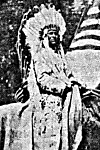The Silent Enemy (1930)
August 2, 1930Release Date
Plot.
Where to Watch.
 Subs
Subs Subs
Subs Subs
Subs Subs
Subs Subs
Subs Subs
Subs Free
FreeCurrently The Silent Enemy is available for streaming online, rent, buy or watch for free on: Amazon Prime Video, MGM Plus, fuboTV, MGM Plus Roku Premium Channel, Amazon Prime Video with Ads, Philo, Kanopy
Streaming in:🇺🇸 United States

Cast & Crew.

Chief Yellow Robe
Chetoga, tribe leader

Chief Buffalo Child Long Lance
Baluk, mighty hunter

Chief Akawanush
Dagwan, medicine man

Molly Spotted Elk
Neewa, Chetoga's daughter

Cheeka
Cheeka, Chetoga's son

Mali Spotted Elk

H.P. Carver
Director

W. Douglas Burden
Story / Producer

William C. Chanler
Producer

Earl M. Welch
Assistant Director

Richard Carver
Writer

Marcel Le Picard
Director of Photography

Julian Johnson
Writer
Media.

Details.
Release DateAugust 2, 1930
StatusReleased
Running Time1h 24m
Content RatingNR
Genres
Last updated:
This Movie Is About.
Wiki.
The Silent Enemy is a 1930 American sound part-talkie directed by H.P. Carver and written by W. Douglas Burden, Richard Carver and Julian Johnson. In addition to sequences with audible dialogue or talking sequences, the film features a synchronized musical score and sound effects along with English intertitles. The drama stars Chauncey Yellow Robe (billed as "Chief Yellow Robe"), Chief Buffalo Child Long Lance, Chief Akawanush and Mary Alice Nelson Archambaud. It premiered on May 19, 1930 at the Criterion Theater in New York City and was later distributed by Paramount Pictures in August of the same year.
The story dramatizes a famine experienced by the post-classical Ojibwe tribe and its leaders (the tribe is anglicized as "Ojibway" in the film). It also depicts a power struggle between skilled hunter Baluk and corrupt medicine man Dagwan.
Before the film begins, Chauncey Yellow Robe greets the audience with a sound speech, in which he explains the tribe's connection to the story and expresses hope for the Ojibwe tribe's history and future.
According to the 26 Dec 1930 Motion Picture Daily, it was filmed in the “timber limits” outside Arnprior, Ontario, while another source cites Lake Temagami as the location. 200 indigenous people were employed in the film's production.
You May Also Like.

The Monkey (2025)

The Maze Runner (2014)

Spider-Man: Homecoming (2017)

Harry Potter and the Goblet of Fire (2005)

Captain America: Civil War (2016)

Avengers: Age of Ultron (2015)

Spider-Man 3 (2007)

The Amazing Spider-Man 2 (2014)

Thor: The Dark World (2013)

Despicable Me 2 (2013)

Need for Speed (2014)

Seven Pounds (2008)

The Good, the Bart, and the Loki (2021)

Atlantis: Milo's Return (2003)

Obi-Wan Kenobi: A Jedi's Return (2022)

Justice League: War (2014)

The Lovers (2015)

Fight Club Rush 10 (2021)


